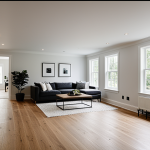Immediate Home Adjustments That Enhance Well-being
Small home changes can quickly boost your mental and emotional state without major renovations. An easy instant well-being tip is adjusting lighting. Switching from harsh overhead lights to softer, warm-toned bulbs or adding dimmers can create a calming atmosphere, reducing stress instantly. Natural light exposure is also key; opening blinds or repositioning seating to catch daylight improves mood and energy levels.
Incorporating plants is another quick home improvement. Plants not only purify indoor air by filtering toxins but also offer an emotional lift through their greenery and the act of nurturing them. Choosing low-maintenance varieties like snake plants or pothos can fit any lifestyle.
In parallel : Hello world!
Decluttering spaces is a powerful yet simple switch that reduces anxiety. Keeping surfaces tidy and organizing belongings minimizes visual noise, which in turn helps boost focus and mental clarity. Even dedicating five minutes daily to declutter can make a notable difference in how serene your environment feels. Embracing these small home changes promotes wellness with minimal effort but substantial impact.
Longer-Term Home Tweaks for Sustained Health
Beyond small home changes, long-term home improvements help nurture ongoing well-being through intentional design and habits. One powerful strategy is rearranging furniture to enhance space flow. Thoughtful placement promotes ease of movement and natural light distribution, reducing feelings of confinement and boosting energy levels over time. Proper flow connects areas for relaxation, work, and socializing, supporting a balanced lifestyle.
Also to discover : How Might Lifestyle Changes Influence the Future of Healthcare in the UK?
Creating dedicated relaxation or mindfulness areas within your home is another effective well-being strategy. Having a specific spot for meditation, reading, or gentle stretching encourages consistent practice of calming habits. Over weeks and months, these spaces become associated with mental unwinding and stress relief, anchoring positive routines.
Ergonomics also plays a crucial role in habit-based home design. Integrating ergonomic furniture and accessories, like supportive chairs and adjustable desks, encourages healthier posture and reduces physical strain. This fosters longer-term physical comfort, which is foundational to emotional well-being.
Combining these long-term home improvements with daily well-being strategies transforms the environment into a sustainable sanctuary, where both body and mind are supported naturally and effectively.
Scientific Explanations Linking Home Environment to Well-being
Understanding the science of well-being helps clarify why certain home adjustments impact mental health so effectively. For instance, studies on the home environment effects show that natural light exposure significantly enhances mood by regulating circadian rhythms. This regulation improves sleep quality and reduces symptoms of depression and anxiety. When you ask, “Why does natural light boost mental health?”, the precise answer lies in its influence on serotonin production and melatonin balance, which are critical for emotional stability and alertness.
Orderliness in living spaces ties closely to stress reduction. Research reveals a clear connection between cluttered environments and elevated cortisol levels, a hormone linked with anxiety. People in tidy, organized areas experience less cognitive load and better focus. This directly answers the question, “How does orderliness reduce anxiety?” by demonstrating that a neat space lowers subconscious stress responses, allowing mental resources to focus on positive activities.
Finally, biophilic design—incorporating natural elements like plants or natural textures—has measurable effects on physiological stress markers, such as blood pressure and heart rate. Psychological research confirms that these elements foster relaxation by engaging our innate affinity for nature. Integrating biophilic elements into your home is therefore more than aesthetic; it actively supports emotional and physical well-being.
Real-life Examples and Practical Tips
When exploring practical home changes, real-life examples reveal how simple adjustments spark well-being transformation. For instance, one family saw reduced tension and more shared moments after decluttering their living room, proving that even a small home change like organizing can foster harmony. This example highlights how maintaining order eases daily stress and improves interactions.
Visualizing before-and-after scenarios motivates action. Imagine a cluttered workspace transformed by adding a small plant, rearranging items for better accessibility, and enhancing natural light exposure. This quick home improvement prompts productivity and uplifts mood, demonstrating accessible steps anyone can take.
For those wondering how to make changes regardless of budget or home size, focus on affordable shifts like swapping harsh lighting with warm-toned bulbs or establishing a corner for mindfulness with cushions and soft textures. Each tip aligns with proven well-being strategies. These practical, low-cost updates combine to create environments that feel inviting and support mental health.
By showcasing these actionable home advice points, readers gain confidence to implement changes that suit their unique living spaces, fostering lasting improvements in well-being and quality of life.







